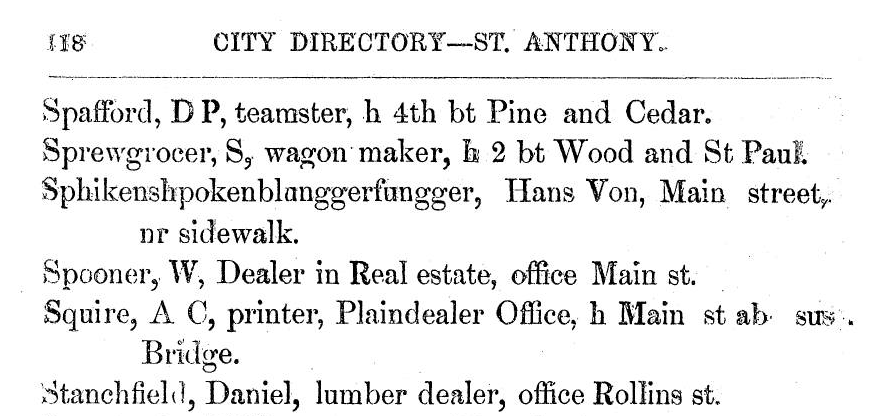I am working up a research proposal to identify all the tenants who lived in Minneapolis’s oldest house between 1853, when the first family moved out, and 1905, when the Hennepin County Territorial Pioneer’s Association bought it with the intention of turning it into a museum. Today I stopped in the special collections room at the Minneapolis Central Library to read through a 1983 research report, newspaper clippings, and other materials about the history of the house.
To my surprise, an article published in the February 13, 1927, issue of the Minneapolis Journal carried the headline, “DO YOU REMEMBER SPHIKENSHPOKENBLUNGGERFUNGGER? He Was Listed in First Minneapolis Directory of 1859, Preserved at Godfrey House.” I will be relying heavily on the Minneapolis city directories for my research, so I already know my way around them. When I checked the city directory from 1859-60, sure enough, there was Hans Von Shpikenshpokenblanggerfungger. According to the directory, he resided, on Main Street near the sidewalk.

Who was Hans Von Sphikenshpokenblunggerfungger? He can’t be found in any census records. Was this a case of atrocious spelling of a long German surname? Was it the whimsical alias of a local comedian? The 1927 newspaper article provides the answer. “Hans was really a joke of the publishers. He never existed save in their fancy, but his name was a byword in the pioneer homes of the time.” Perhaps it was a derisive nickname used by Yankee residents for German and Scandinavian immigrants in the city (though there wen’t that many yet in 1859; most residents were from New England or upstate New York).
The moral of the story is, you never know what real or fictitious people you will run across when doing genealogy research!

